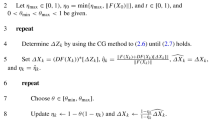Abstract
The factorization method, which has previously been used to solve inverse scattering problems, is generalized to geometric inverse problems of static elasticity. We prove that finitely many defects (cavities, cracks, and inclusions) in an isotropic linearly elastic body can be determined uniquely if the operator that takes the forces applied to the body outer boundary to the outer boundary displacements due to these forces is known.
Similar content being viewed by others
References
A. Kirsch, “Characterization of the Shape of a Scattering Obstacle Using Spectral Data of the Far Field Operator,” Inv. Probl. 14 (6), 1489–1512 (1998).
A. Kirsch, “Factorization of the Far Field Operator for the Inhomogeneous Medium Case and Application to Inverse Scattering Theory,” Inv. Probl. 15, 413–429 (1999).
A. Kirsch, “New Characterizations of Solutions in Inverse Scattering Theory,” Appl. Anal. 76, 319–350 (2000).
P. Hahner, “An Inverse Problem in Electrostatics,” Inv. Probl. 15 (4), 961–975 (1999).
M. Bruhl and M. Hanke, “Numerical Implementation of Two Non-Iterative Methods for Locating Inclusions by Impedance Tomography,” Inv. Probl. 16 (4), 1029–1042 (2000).
I. N. Grinberg, “Obstacle Visualization via the Factorization Method for the Mixed Boundary Value Problem,” Inv. Probl. 18 (6), 1687–1704 (2002).
R. Kress and L. Kühn, “Linear SamplingMethods for Inverse Boundary Value Problems in Potential Theory,” Appl. Numer. Math. 43, 1–2 (2002).
T. Arens, “Linear SamplingMethods for 2D Inverse ElasticWave Scattering,” Inv. Probl. 17 (5), 1445–1464 (2001).
C. J. S. Alves and R. Kress, “On the Far-Field Operator in Elastic Obstacle Scattering,” IMA J. Math. 67 (1), 1–21 (2002).
A. Charalambopoulos, A. Kirsch, K. A. Anagnostopoulos, et al., “The FactorizationMethod in Inverse Elastic Scattering from Penetrable Bodies,” Inv. Probl. 23 (1), 27–51 (2007).
R. Potthast, “A Survey on Sampling and ProbeMethods for Inverse Problems,” Inv. Probl. 22 (2), R1–R47 (2006).
A. Kirsch, “The FactorizationMethod for a Class of Inverse Elastic Problems,”Mathematische Nachrichten 278 (3), 258–277 (2005).
Author information
Authors and Affiliations
Corresponding author
Additional information
Original Russian Text © E.I. Shifrin, 2016, published in Izvestiya Akademii Nauk, Mekhanika Tverdogo Tela, 2016, No. 5, pp. 68–78.
About this article
Cite this article
Shifrin, E.I. Factorization method in the geometric inverse problem of static elasticity. Mech. Solids 51, 562–570 (2016). https://doi.org/10.3103/S0025654416050083
Received:
Published:
Issue Date:
DOI: https://doi.org/10.3103/S0025654416050083



